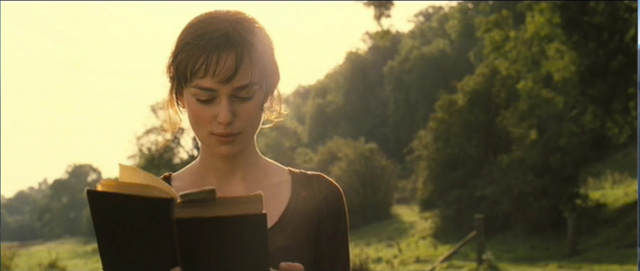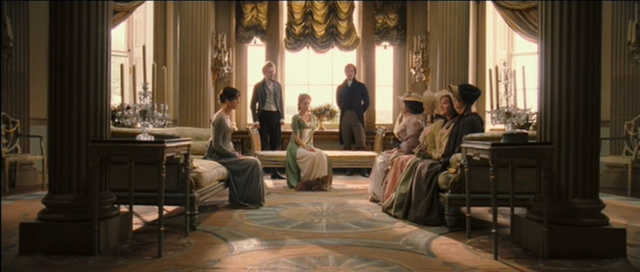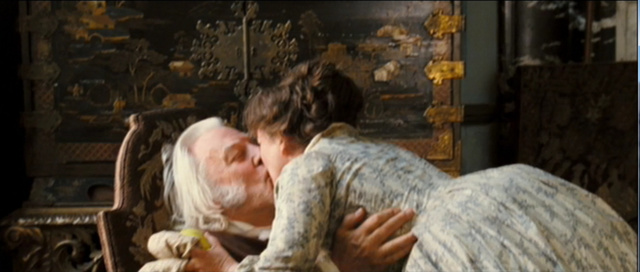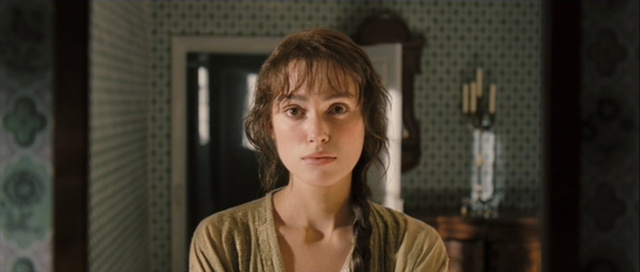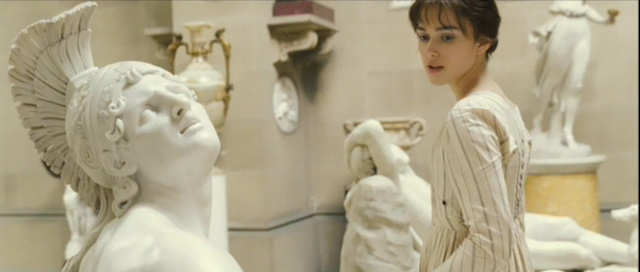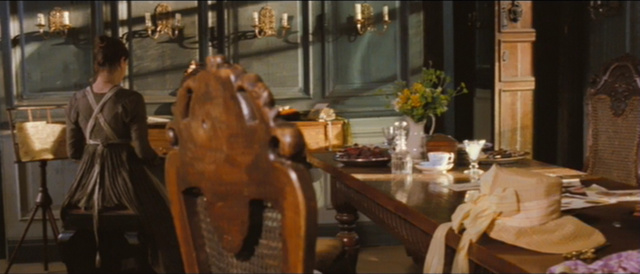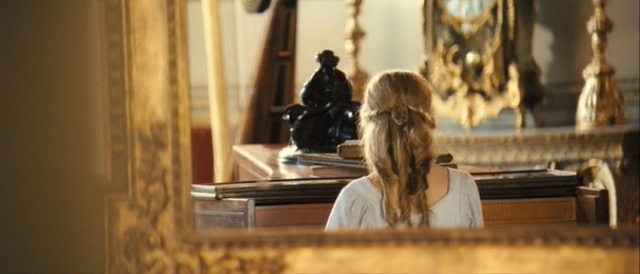|
“dear Jane”—the elegant close-up on Elizabeth Bennet’s handwriting in Joe Wright’s Pride & Prejudice (2005) offers one of the most inspired visual representations of the dialogic nature of film adaptation. What seems an address to the writer hints at the movie’s very act of bringing the novel to life. It also seems to wink at Austen’s Janus-faced icon in the collective imagination, poised between the traditional image of propriety, decorum, and allegiance to the patriarchy, and the more recent interpretations of her work as transgressive, radical, post-colonial, and proto-feminist. If readers construct the meanings of a novel through a variety of interpretations, in metaphorical terms they write it back; theatrical or filmic adapters, in their turn, literally rewrite a novel for new audiences. The alterations of existing elements or the inclusions of new ones merge into a new work that both echoes and diverges from its literary source. As Jocelyn Harris points out, “the delight is in the difference” (52), that is in the fluctuation between present and absent features.
The principles of variation and repetition seem to inform the multi-layered fabric of Wright’s Pride & Prejudice in its narrative, visual, and musical components. What makes the film different from previous transpositions of Austen’s masterpiece is its extraordinary playfulness. An often-neglected aspect of Austen’s text, the entertaining quality of the story is rendered on the screen through the recurrence of images and themes used to open and close scenes—giving a dreamy touch to the film—and through a series of changes affecting characters and their relationships. The latter variations to Austen’s novel also bear “markers of modernity”: they are especially intended to update the story for a contemporary audience, and they offer an original and at times postmodern version of Pride and Prejudice.
Not only is the very idea of repetition used to mark Austen’s umpteenth return to the screen, but the film also plays on its derivative nature by both adopting and defying some prevailing filmic conventions. Indeed, Wright’s Pride & Prejudice highlights the differences from its source text from the very beginning.1 After a long shot of the English countryside at dawn, the camera focuses on a close-up of Elizabeth Bennet (Keira Knightley) reading a book. Opening a film adapted from a novel with the image of a book—often the transposed text itself—has been a common device since David Lean’s Great Expectations, a film Wright acknowledges as the source for a subsequent shot during the ball at Netherfield.2 The ironic smile on Elizabeth’s face adds to the impression that the novel in question could be by Jane Austen, possibly Pride and Prejudice itself.3 However, the book motif here produces a divergent effect. The camera shows that Elizabeth is reading the last pages of the book; therefore, the very act of shutting it and the words “The End” clearly visible in the close-up indicate not so much the aspiration to fidelity emphasized in Lean’s adaptation as the distance from Jane Austen’s text.
While marking a shift from traditional theories of fidelity to the modern notion of intertextuality, the book’s closure signals a transition into another medium.4 Staging and dispelling its first prejudice—the assumed primacy of the word over the image—Wright’s film plays with a variety of texts, ranging from Austen’s novel to eighteenth-century painting, from film transpositions of English classics to former TV and cinematic versions of Pride and Prejudice: notably the 1940 MGM film; the beloved 1995 BBC series starring Jennifer Ehle and Colin Firth; the more recent Mormon version, A Latter-Day Comedy (2003); and the Bollywood-style rendition, Bride and Prejudice (2004).5
The choice to set the events in 1797, when First Impressions, the early version of Pride and Prejudice, was completed, rather than in the early nineteenth-century, can be considered as the major narrative variation implemented by Wright’s film, accounting for the liveliness conveyed by every single shot steeped in Georgian energy. The film has been credited with freeing or “liberating” (Morris) the vital potential of the novel, in Austen’s famous definition “light & bright & and sparkling” (4 February 1813).
More important, the temporal change requires a very fluid camerawork. If painterly, frames are never static: thanks to Roman Osin’s cinematography, relying on long and complex tracking shots, the animation in the scenes fades into the movement of the scenes. Life pervades the visual field in its natural, animal, and human components. The sounds of nature, birdsong (especially of blackbirds), the permanent presence of dogs, chickens, pigs, and geese create a realistic, kinetic picture, which brings to the center of the frame particulars usually left offstage in costume dramas and in the customary Regency adaptations of Jane Austen. The long tracking shot during the first sequence follows Elizabeth as she is coming home: though establishing her as the privileged focal subject of the film, the camera soon leaves her in order to sneak into the house, gliding from room to room through doors and windows, showing its messiness and noisiness. After tracking in, from behind, to Mary (Talulah Riley) playing the piano, in a visual composition reminiscent of Vermeer, the camera rambles around the room dwelling on details of dress, decoration, and furniture, taking in the ribbons, flowers, and books scattered on the table. Just as in a Flemish painting, the sunlit environment, with the Veermerian predominance of blue and yellow shades, radiates an atmosphere of hearty domesticity in which people are caught in their different activities.
The fluidity of camerawork is paralleled in the contiguity between animate and inanimate elements. The human landscape appears likewise spirited: Jane (Rosamund Pike) almost obstructs the camera movement while Kitty (Carey Mulligan) and Lydia (Jena Malone) enter the scene running down the stairs and rushing into another room. Their dresses are not elaborate, their hair is often ruffled, they seldom wear bonnets, and they are really young. The eighteenth-century resetting exalts the pleasures of the flesh: eating and vigorous dancing fill the screen during family breakfasts, dinner scenes, and energetic balls (with vigorous dances in place of the more formal and stately ones usually depicted). The film allows the viewers to see behind the scene of Austen’s page, dramatizing what happens after the doors are closed or before a visitor is received at Longbourn. The humor that springs from such sequences, as the Bennet women try to recover their composure just before Bingley (Simon Woods) and Darcy (Matthew MacFadyen) are announced, directly points to the Bennets as a colorful, heterogeneous, bickering but united family. While in the 1995 BBC series the framing stressed the distance and the spiritual divide between Jane and Elizabeth on the one hand, and their sisters and mother on the other (Belton 188), in Wright’s Pride & Prejudice, conversely, the sisters and their mother are generally framed together in different pentagonal compositions or shown running after each other. As has been observed by the actors themselves and the crew, to a certain extent this reality effect and the sense of community masterfully staged on the screen can be ascribed to the close and collaborative relationships the members of the cast developed during the shooting, contributing their own ideas to the process of adaptation
Throughout the film, however, the bright household of the Bennets is repeatedly contrasted with the stiffness of the aristocratic manors. Not only are the hours at Netherfield punctuated by the repetitive sound of the clock, but the characters are, as a rule, seated; if walking around the room, as Elizabeth and Miss Bingley do, their movements are as affected as if determined by stage directions.
The tendency to “freeze” the characters into still shots within the refined interiors of Netherfield—partly a graceful homage to the eighteenth-century pictorial conventions—is magnified at Rosings with ideological implications. Standing close to each other, Darcy, Colonel Fitzwilliam, and Mr. Collins (Tom Hollander) embody in a single shot the upper and middle classes of English society. By addressing the issue of class distinctions, the film resists the nostalgic cult of the English country house extolled in heritage cinema and in Austen adaptations at large.6 If in its place the equally undying myth of merry England is revived to oppose the crippling exclusiveness of a class system based on rank and money, Wright’s adaptation eludes the viewer’s expectations in offering no simple, one-sided ideological vision.
This defiance of easy ideological dogmas clearly betrays the contemporary lenses of Wright’s transposition and its creative variations on the ethical universe of Austen’s novel. Compared with the popular BBC miniseries, Wright’s film replaces the solipsistic quality of the relationship between Elizabeth and Darcy with a more comprehensive dramatization of the social and emotional drives underpinning the story and affecting several characters. It is in characterization, particularly in the figures of Elizabeth and Mr. and Mrs. Bennet (Donald Sutherland and Brenda Blethyn), that many markers of modernity—i.e., signs of Wright’s updating of Austen’s story—can be detected. Filmic manipulations of the novel’s dialogues, streamlined or paraphrased for dramatization’s sake, encourage a particular range of responses or infuse a set of moral values. For example, through the elliptical compressions and omissions of important lines, especially the long speech about his paternal faults after Lydia’s elopement, Mr. Bennet is converted into a more solicitous father; his wit and sensitivity are heightened by the emotive performance of Donald Sutherland. Straying from the novel, he always escorts his family, firmly casting a watchful eye on Mr. Collins during the ball at Netherfield.
By contrast, both Lizzie and her mother undergo an analogous process of feminine intensification and emotional empowerment through the insertion of short but meaningful retorts. As the screenwriter Deborah Moggach allowed in an interview, she tried to accentuate Mrs. Bennet’s “heroic” side, particularly in her struggle against the entail hanging over the Bennet family. Mrs. Bennet’s comic quality, her several failings, and her compulsive matchmaking are preserved in the script and counterbalanced, in some cases even induced, by an unreserved affection for her family.7 Far from being “invariably” silly, she spares no effort in the attempt to save her daughters from the looming menace of a grim, and homeless, future. In the postmodern world of Wright’s adaptation, Mrs. Bennet is vindicated by a verbal exchange with Elizabeth. Responding to the mirth with which her mother receives the news of Lydia’s marriage, Elizabeth seems to voice the reaction of the majority of Austen’s readers: “Is that really all you think about?” Mrs. Bennet’s reply is telling: “When you have five daughters, Lizzie, tell me what else will occupy your thoughts. And then perhaps you will understand!” Later in the film, during the moving parting scene with Lydia, her strenuous self-defense is rewarded by Elizabeth’s embrace, which symbolically sanctions her sensitivity. In Wright’s adaptation, the depth of Mrs. Bennet’s motherly love redeems her figure from her vulgarity and lack of manners.
In addition, the film goes so far as to mold a different relationship between Elizabeth’s parents who, though playing the ever-quarrelling couple before their daughters, form a nice pair behind the scenes. Their intimacy is brought to light in an elegant pan during which, lingering from one to the other of Longbourn’s lighted windows, the camera shows from an unreal point-of-view the rooms’ interiors and the activities of their occupants. A recurrent feature of the film, these “doll’s house” shots reaffirm the primacy of family ties, a further marker of the film’s modernity. In many respects, Wright’s changes in the representation of the Bennets are clearly aimed at encouraging the identification of contemporary cinemagoers with the protagonists, who mainly embody twentieth-century notions of love and marriage.
Similarly, Knightley’s Lizzie is a more nuanced character than her cinematic predecessors: not only is she given some of Mr. Bennet’s biting lines (as during the dinner with Mr. Collins), but the alterations to Austen’s dialogues introduced by the screenwriter Deborah Moggach are oriented to update her personality. In the novel she simply tells the story of Darcy’s assessment of her as “‘tolerable’” “with great spirit among her friends” (12). In the film, however, to Darcy’s question “What do you recommend to encourage affection?” she boldly retorts, “Dancing, even if one’s partner is barely tolerable.” Bordering on impudence, Elizabeth’s digs, which would be shocking and inappropriate to a Regency reading public, disclose to the contemporary audiences a strong-willed and modern character. Even given the feminist assumption that Austen’s story is conservative at its heart, since by marrying Darcy Elizabeth succumbs to his patriarchal narrative, Wright’s Pride & Prejudice aims at redressing the unbalanced relation “between Elizabeth’s energy and Darcy’s power” (Stewart 42).
In this connection, it is worth noting that the modern refashioning of the figure of Elizabeth is altogether colored with psychoanalytic overtones.8 Elizabeth’s gradual discovery of Darcy’s true character entails a concurrent process of self-knowledge, unfolded in the transition from a projective perception of the other, regarded as a receptacle of her own needs and desires, to the full recognition of Darcy as an independent being. In order to emerge from the “shadow of the other” (Benjamin 1), Elizabeth must go through a series of epiphanic experiences and psychological re-adjustments subtly evoked on the screen. According to John Wiltshire (112), Darcy’s first proposal and his subsequent letter seal her first moment of recognition: “‘Till this moment, I never knew myself’” (208). In the film Benjamin’s stages are transposed almost literally: after the proposal, the viewer is denied any close-up on Elizabeth; the camera tracks after her in the dark corridor, and her face remains in shadow till she reaches the mirror.
A common trope for self-revelation, the inclusion of the long mirror shot answers the double purpose of giving palpable form to Elizabeth’s revision, while conveying the passing of time. More important, this reflexive gaze marks the crowning moment of subjective identification between viewer and character since Knightley is actually looking at the camera. In other words, we are Elizabeth.
Lizzie’s emotional development takes a step further at Pemberley, where the film’s play on the visual and its intertextuality are articulated during the magnificent sequence in the sculpture gallery. Brought about by practical considerations, the choice to replace Austen’s picture gallery with the precious statuary of Chatsworth—one of the most inventive variations of the film—proves a perfect aesthetic device to express the heroine’s inner turmoil and awakening desire. The feeling of plasticity emanating from the marble, including Darcy’s bust, is more effective than any painting in giving the impression of figures on the point of becoming animate. Not surprisingly, “living sculptures” is the title of the cue underscoring the scene. The sequence also stages Elizabeth’s sexual growth as she seems particularly intrigued by nude bodies, both male and female, painted on the ceiling or personified in the statues in the public rooms of Pemberley.9
Moreover, Elizabeth’s acquaintance with Pemberley is portrayed as a sensory experience: she touches everything, even running her hands over a statue of Janus—tellingly, the Roman guardian of doorways and gates. The whole sequence centers less on Elizabeth’s knowledge of Darcy than on her self-image, here given the bodily form of a sculpture. With a round shot, the camera holds on her contemplation of a statue of a woman whose veiled features are the artistic embodiment of Elizabeth’s mental state. If not still in the darkness of Hunsford Parsonage, metaphorically her face is still invisible, yet the veils of prejudice and self-deception seem now reduced to thin layers.
Concomitantly, the scene reverberates with intertextual echoes. The diaphanous sensuality of Canova’s sculptures, the circular camera movements, and the high-angle shots on Elizabeth’s puzzled gaze closely resemble Rossellini’s sequence at the Archaeological Museum of Naples in Voyage in Italy. Just as for Catherine/Ingrid Bergman, Elizabeth’s visit marks a moment of revision and retrospection, a voyage into her inner landscape. Only through a graduated set of personal and mutual negotiations can Elizabeth, and Darcy with her, enjoy love in its fullest sense, a balanced feeling between submission and possession. As Wright puts it in his commentary, the film aspires to express “how difficult it is to fall in love, how painful, and terrifying, and scary to let yourself fall in love.” If the several bridges Elizabeth repeatedly crosses throughout the film help to pinpoint her independent spirit, first and foremost they visualize the objective correlative for the complex and dialogical nature of human attachment.
In the image of the bridge lies the governing principle of the film, organized around the insistent repetition of figurative, stylistic, and musical patterns. From a visual angle, the distorting force of first impressions and false assumptions is converted into the pervading presence of doors and windows, unconventionally open. Rather than marking metaphorical boundaries or obstructing the vision, these doors and windows stand for the lenses of our understanding. They emblematize, in a Kantian sense, the veils of human perception, alluding to the several types of pride and prejudice displayed in the story. At the same time, doors are employed as editing tools, intensifying the dramatic shape of Austen’s writing. The wings of Meryton assembly hall open before the camera, initiating the ball scene; the polished closing door of Netherfield Hall symmetrically marks the departure of Mr. Bingley and his separation from Jane. Dividing the narrative into a succession of distinct moments or acts, these stage expedients typify the cinematic rendering of such passages as the opening of Chapter 19: “The next day opened a new scene at Longbourn” (104).10
Multiple tactics lend a circular shape to the filmic fabric: the cross fade of opening and closing doors; the alternation of beginnings and endings, of books, of letters, of dances; the round architecture of the temple where Darcy proposes to Elizabeth for the first time; the numerous turns of the characters, notably Mrs. Bennet’s; the choice to set the first and the last scene at dawn. This circularity is skillfully reflected in the camerawork. The repeated winding camera movements and angle shots function as cinematic tropes, merging and converging in the swing sequence, where Elizabeth slowly winds up the ropes and then begins to twirl. The resort to the slow motion POV shot enables Wright to show in a long round-pan the periphery of Austen’s world—ruddy-faced peasants, farm animals, the dirt and hay surrounding the Bennets’ property—as well as to condense in the dreamy passing of the seasons the novel’s emphasis on the moral implications of the temporal element.
Granted the film’s vibrant veneer, the re-emergence on the screen of images and filmic motifs has a chiming, incantatory effect that produces a fairy tale dimension. It is not preposterous to maintain that the balanced love eulogized in Austen’s novel is mirrored in the film’s constant poising between realism and daydream. This tension, brought about by the visual and musical repetitions, is part of the film’s metafictional flavor, for, as with fairytales, it points to the retelling of an overtold story. It is no coincidence that the dreamy feeling mainly suffuses scenes and episodes added by Moggach, variations on Austen’s plot. Nowhere do visual beauty and mystery come together more vividly than in the evocative atmosphere of the final (at least for the European audience) and climactic encounter between Elizabeth and Darcy.11 Judged by the director as “probably over romantic,” the entire scene is suffused with reminders of the opening: the slow camera tracking, Elizabeth’s crossing a small bridge, the country quietly awakening, the dissipating mist, the sun rising, all mingle to reassert the film’s circular structure. In this light, Wright’s magic realism creatively translates Austen’s encouragement to get beneath the surface of first impressions to unearth, as suggested by the title of the underscore, “The Secret Life of Daydreams.”
In line with the film’s iterative framework, musical themes and patterns recur in Dario Marianelli’s soundtrack. More than any other cinematic track, the underscore is integral on many levels to the logic of Wright’s adaptation. From a narrative point of view, music plays an important role in Austen’s novel, as a major form of entertainment, as one of the marks of feminine accomplishment, as a topic of conversation, and, strategically, as a vehicle for (mis)understanding, as proved by the famous analogy between practicing the piano and “practicing” social amiability that Elizabeth sets against Darcy’s uncommunicativeness at Rosings. At every turn, cues are conventionally combined to chart Elizabeth’s oscillating responses towards Darcy, ranging from mistrust and contempt to gratitude and love, underpinned by uncertainty and discouragement. From a stylistic perspective, Marianelli’s compositions after the period style and the accuracy of sound effects, offered by actual piano and dance performances on screen, consolidate the sense of immediacy and add to the realistic atmosphere.
On the other hand, Austen’s playfulness and the story’s romantic flavor are acoustically evoked by blurring the boundaries between the background and the source planes in a network of returning tunes and techniques. Once again, the first sequence is essential in establishing this musical interplay: the English countryside seems to wake up to the sound of blackbirds twittering (from now on Elizabeth’s sound motif), which then fades into the main theme, a piano sonata entitled “Dawn,” whose first, hesitant notes start at the first rays of sunlight. As soon as the camera reaches Elizabeth’s home, it moves in and holds on the back of a girl (Mary Bennet) at a piano, who is naturally identified as the player of the theme. Ironically, this first impression is soon denied by the dull sound of scales overlapping for a brief moment with the main score. In the span of a sequence, the film’s main topic and its narrative intermixing of real and unreal are woven into the musical texture. Wafting through the misty landscape of Elizabeth and Darcy’s final scene, the piano sonata implements musically the paradigms of circularity and repetition. Its mesmerizing melody resounds with flowing or melancholy modulations from sequence to sequence, both as background music and source music, first played, and very badly, by Elizabeth at Rosings, and then superbly executed by Georgiana Darcy at Pemberley. The piano leitmotif is even awarded narrative relevance, becoming the means for the two lovers’ meeting at Pemberley as Elizabeth is attracted to the door by the familiar sound of the piano sonata. Besides re-enacting the opening tracking shot of the film, the scene further replicates Elizabeth’s own performance of the piece. These echoes are visually suggested in the mirror that reveals Georgiana’s figure, and the musical theme prefigures Pemberley as Elizabeth’s future home.
As sound effects make clear, the film not only vibrates with acoustic repetitions but is also conceived in musical terms, explicitly designed in sonata form, with an exposition, a series of developments and modulations, a final reprise and a “coda” (Wright’s very term for the closing scene between Elizabeth and her father). In many respects, the film’s narrative, visual, and musical variations on the novel directly hint at the creative nature of adaptation, first ratified by Jane Austen herself, who notoriously appropriated, parodied, transformed, and alluded to characters and situations drawn from diverse texts and literary traditions.
In hindsight, the trope of return dominates Pride & Prejudice, investing the film’s multi-track structure with its semantic conflagrations: Jane waits for Bingley’s reappearance; Elizabeth must learn to reciprocate Darcy’s love; the film itself returns the novel into a new form, as Austen’s novel has reworked previous sources. Ultimately, the film heralds the return of Jane Austen to the screen, and a very fortunate one. The variants and changes made by Moggach and Wright to the novel’s plot and characterization, the film’s meta-textual hints, fluid camerawork, and daydreaming mood, together with the recurrence of visual and musical tropes, openings and closings, all contribute to update and magnify Austen’s witty style. Wright’s Pride & Prejudice stands out in its visual enjoyableness and stylistic originality, qualities that perfectly chime with Austen’s writing, whose main purpose was that of entertaining her readers.
Notes
1. On the metafictional aspects of the film, see David Roche.
2. In his audio commentary for the DVD version of the film, Wright also cites Pip’s smashing into Magwitch’s chest in David Lean’s Great Expectations as his source for Elizabeth’s physical collision with Darcy during the ball at Netherfield.
3. Both David Roche and Susan Fraiman have also highlighted Elizabeth’s amused expression. Roche, in particular, has verified the correspondence between Austen’s final lines with the text of the novel shown in the film, in which only the names of characters and places appear to have been replaced. Moreover, Roche notes that to a certain extent Lizzie’s repeated smile in the act of shutting books throughout the film betrays her capacity to read critically.
4. See the introduction to Robert Stam and Alessandra Raengo’s Literature and Film (2003).
5. Major collections devoted to film adaptations of Austen’s novels are Linda Troost and Sayre Greenfield’s Jane Austen in Hollywood and Gina Macdonald and Andrew F. Macdonald’s Jane Austen on Screen (see especially chapters by Ellen Belton and Jocelyn Harris). On Wright’s Pride & Prejudice, see the special issue of Persuasions On-Line 27.2 (2007). For a comparative discussion of cinematic versions of Pride and Prejudice, see Deborah Cartmell’s Screen Adaptations: Jane Austen’s Pride and Prejudice: The Relationship Between Text and Film (2010).
6. The use of Chatsworth for Pemberley, in a sense, can be inscribed in the realistic attitude governing the choices of the adaptors and producers since some argue that Austen too modeled Pemberley on Chatswoth. For a comparative analysis of the representations of Pemberley in the 1979, 1995, and 2005 versions of Pride and Prejudice, see Linda V. Troost’s “Filming Tourism, Portraying Pemberley” (2006).
7. Different film characterizations of Mrs. Bennet are discussed by June Sturrock.
8. My reference is to Julian Wilmot Wynne’s Jane Austen and Sigmund Freud: An Interpretation (1998).
9. On the eroticization of Chatsworth, and this scene in particular, see Susan Fraiman.
10. Wright’s theatrical experience, especially with marionettes—his parents founded Islington’s Little Angel Theatre—might account for these “stage” stylistic effects interspersed throughout the film.
11. For American distribution, Wright added a gaudy scene with the married couple sitting in their pajamas and surrounded by candles in Chatsworth Park.
Works Cited
Austen, Jane. The Novels of Jane Austen. 3rd ed. Ed. R.W. Chapman. Oxford: Oxford UP, 1932. Belton, Ellen. “Reimagining Jane Austen: the 1940 and 1995 film versions of Pride and Prejudice.” Jane Austen on Screen. Ed. Gina Macdonald and Andrew F. Macdonald. Cambridge: Cambridge UP, 2003. 175-96. Benjamin, Jessica. Shadow of the Other: Intersubjectivity and Gender in Psychoanalysis. London: Routledge, 1998. Bride & Prejudice. Dir. Gurinder Chadha. Writ. Paul Mayeda Berges and Gurinder Chadha. Pathé Pictures/Miramax, 2004. Cartmell, Deborah. Screen Adaptations: Jane Austen’s Pride and Prejudice: The Relationship Between Text and Film. London: Methuen, 2010. Fraiman, Susan. “The Liberation of Elizabeth Bennet in Joe Wright’s Pride & Prejudice.” Persuasions On-Line 31.1 (Win. 2010). Harris, Jocelyn. “‘Such a transformation!’ Translation, Imitation and Intertextuality.” Jane Austen on Screen. Ed. Gina Macdonald and Andrew F. Macdonald. Cambridge: Cambridge UP, 2003. 44-68. Le Faye, Deirdre, ed. Jane Austen’s Letters. Oxford: Oxford UP, 1995. Macdonald, Gina, and Andrew F. Macdonald, eds. Jane Austen on Screen. Cambridge: Cambridge UP, 2003. Morris, Wesley. “A Radiant Take on a Classic Love Story.” Boston Globe 11 Nov. 2005. http://www.boston.com/ae/movies/articles/2005/11/11/a_radiant_take_on_a_classic_love_story/?page=full Pride and Prejudice. Dir. Andrew Black. Writ. Anne K. Black, Jason Faller, and Katherine Swigart. Bestboy Productions/Excel Entertainment, 2003. Pride and Prejudice. Dir. Robert Z. Leonard. Writ. Aldous Huxley and Jane Murfin. Perf. Greer Garson and Laurence Olivier. MGM, 1940. Pride and Prejudice. Dir. Simon Langton. Writ. Andrew Davies. Perf. Jennifer Ehle and Colin Firth. BBC/A&E, 1995. Pride & Prejudice. Dir. Joe Wright. Writ. Deborah Moggach. Perf. Keira Knightley and Matthew Macfadyen. Focus, 2005. Roche, David. “Books and Letters in Joe Wright’s Pride & Prejudice (2005): Anticipating the Spectator’s Response through the Thematization of Film Adaptation.” Persuasions On-Line 27.2 (Sum. 2007). Stam, Robert, and Raengo, Alessandra, eds. Literature and Film. Oxford: Blackwell, 2003. Stewart, Maaja A. Domestic Realities and Imperial Fictions: Jane Austen’s Novels in Eighteenth-Century Contexts. Athens: U of Georgia P, 1993. Sturrock, June. “Mrs. Bennet’s Legacy: Austen’s Mothers in Film and Fiction.” Persuasions On-Line 29.1 (Win. 2008). Troost, Linda, and Sayre Greenfield, eds. Jane Austen in Hollywood. 1998. 2nd ed. Lexington: UP of Kentucky, 2001. Troost, Linda V. “Filming Tourism, Portraying Pemberley.” Eighteenth-Century Fiction 18.4 (2006): 477-98. Wiltshire, John. Recreating Jane Austen. Cambridge: Cambridge UP, 2001. Wynne, Julian Wilmot. Jane Austen and Sigmund Freud: An Interpretation. London: Plume, 1998.
|



